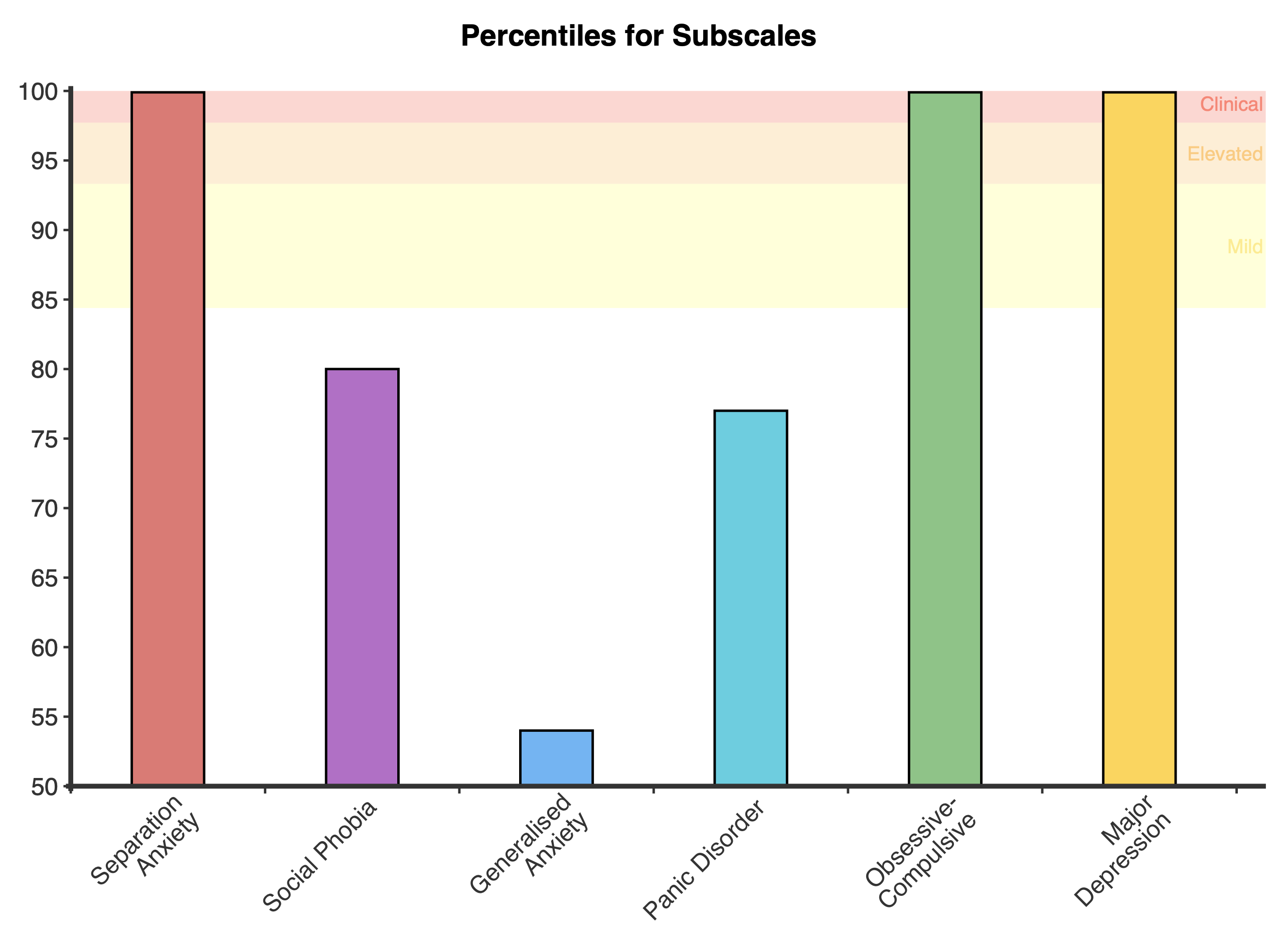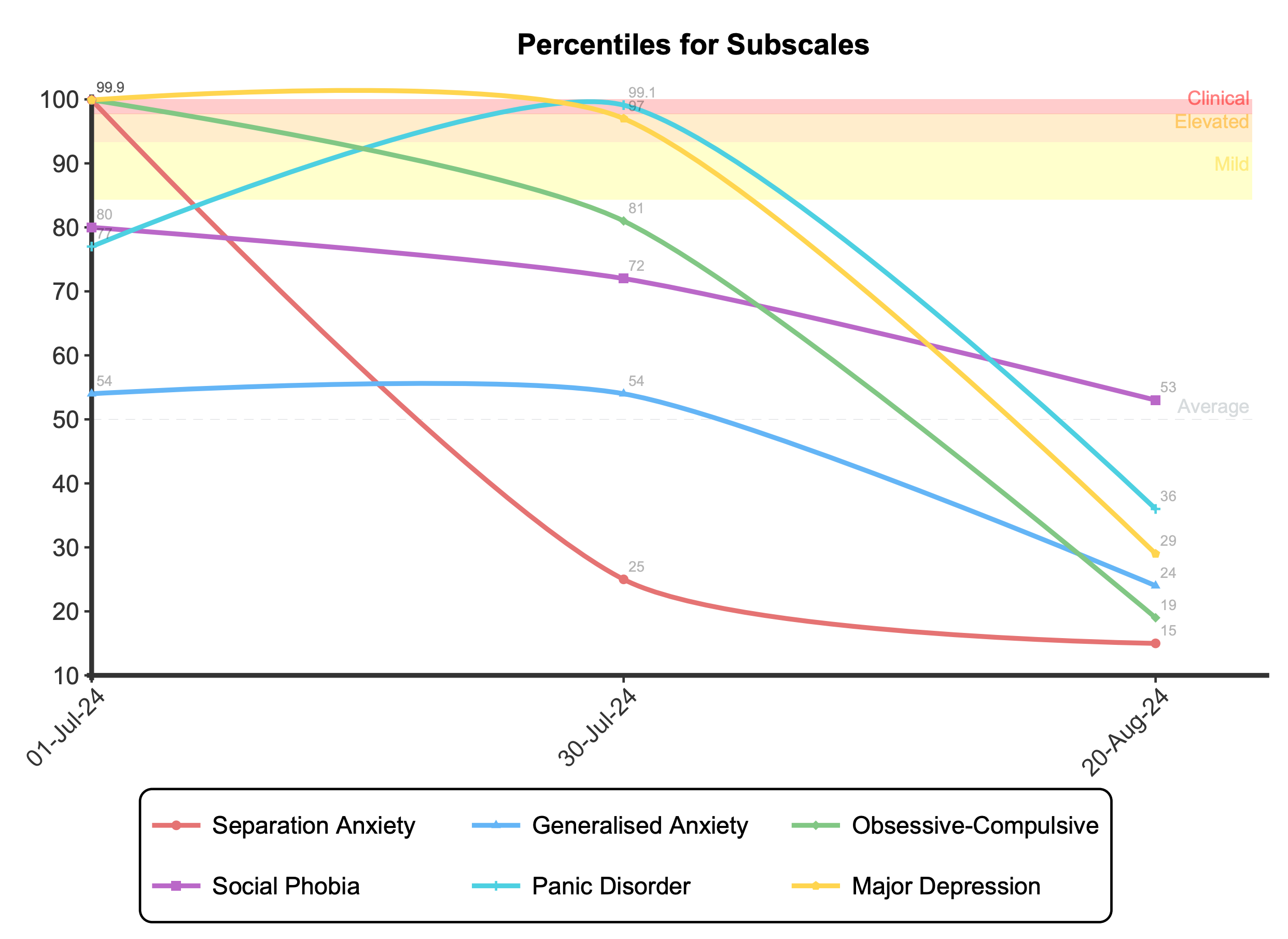he Revised Child Anxiety and Depression Scale – Parent version (RCADS-Parent) is a 47-item questionnaire designed to assess symptoms of anxiety and depression in children and adolescents aged 8 to 18 years, as reported by their parents.
The measure consists of six subscales that screen for high prevalence disorders in youth:
In addition to the subscales, a Total Internalising score that is a combination of all six subscales is provided that gives an overall indication of the level of internalising problems. A Total Anxiety score that is a combination of the five anxiety subscales provides an overall indication of anxiety problems.
A parallel self-report version, the RCADS-Child, can be used in conjunction with the RCADS-Parent to gather additional clinical information. The RCADS is well-suited for screening and monitoring of anxiety and depressive symptoms in youth.
Example RCADS-Parent Items
The RCADS-Parent yields a Total Internalising Scale (sum of all 6 subscales) and a Total Anxiety Scale (sum of 5 anxiety subscales) to provide an overall indication of symptom severity. Higher scores are indicative of more difficulties and greater symptom severity.

The RCADS provides raw scores for the six subscales that are converted to percentiles based on the child’s age group (8-10, 11-12, 13-14, 15-16, or 17-18 years) and gender (Ebesutani et al., 2011). A percentile of 50 reflects the average symptom level relative to age and gender-based peers, while increasingly higher percentiles indicate more severe symptoms (e.g. > 93.31st percentile signifies elevated symptoms).
A descriptor is provided based upon the following criteria:

The six subscales assessed by the RCADS-Parent are:
The RCADS subscales are best conceived as dimensional symptom clusters rather than diagnostic categories. Higher scores suggest greater symptom severity and clinical risk and should be integrated with clinical judgement to guide diagnostic formulation and treatment planning.

Plots demonstrating the subscale percentiles are presented upon first administration. Longitudinal plots are displayed for both the subscale percentiles and the Total Internalising percentile upon multiple administrations to enable tracking of symptoms over time.
The RCADS-Parent was validated in a community sample of 967 parents of children and adolescents (Ebesutani et al., 2011). The RCADS-Parent demonstrated high internal consistency (total score = 0.93), test-retest reliability (2-weeks = 0.69 – 0.89), and good convergent/divergent validity (r = 0.70 with CBCL Anxious/Depressed scale; Ebesutani et al., 2011). Factor analysis revealed that it also supported the 6 factor structure of the RCADS-Parent; separation anxiety disorder, social phobia, generalised anxiety, panic disorder, obsessive compulsive disorder and major depressive disorder (Ebesutani et al., 2011).
The Ebesutani et al. (2011) study provides normative data for children between 8-18 years of age, and is used to derive percentile scores. The grades are used to estimate the age of the children in the sample and is consistent with the official scoring (see https://rcads.ucla.edu/scoringoverview) for the Ebesutani et al. (2011) sample except that NovoPsych includes ages 8-10 in the Grade 3 & 4 bracket (whereas the official RCADS scoring sets this as ages 9-10 despite the Ebesutani et al. (2011) sample including 8-year olds). If gender is not specified for the client (or non-binary is selected), then a combined male/female and age 8-18 mean and standard deviation (as specified by Ebesutani et al. (2011)) is used for calculating the percentiles.
Descriptors are based upon T-Scores, however for ease of interpretation these scores are converted to percentiles:
A reliable change score has been determined by NovoPsych for the Internalising Score from data collected between July 2020 and July 2024 where clients had completed multiple RCADS-Parent assessments. All data was included in the analysis, so no data was removed based upon initial symptom severity. The resultant sample size was 4,664. The reliable change score was calculated using the Jacobson-Truax method of clinical significance classification (Jacobson & Truax, 1991) using calculated Cronbach alpha’s from the NovoPsych data. The internal reliability calculated for the Internalising Score was 0.95 and the reliable change score calculated was 14, indicating that scores that change 14 points or more are indicative of clinically significant change.
Chorpita, B.F. & Spence, S.H. (1998).
Chorpita, B. F., Yim, L., Moffitt, C., Umemoto, L. A., & Francis, S. E. (2000). Assessment of symptoms of DSM-IV anxiety and depression in children: A revised child anxiety and depression scale. Behaviour research and therapy, 38(8), 835-855.
Ebesutani, C., Chorpita, B. F., Higa-McMillan, C. K., Nakamura, B. J., Regan, J., & Lynch, R. E. (2011). A psychometric analysis of the Revised Child Anxiety and Depression Scales–parent version in a school sample. Journal of abnormal child psychology, 39(2), 173–185. https://doi.org/10.1007/s10802-010-9460-8
NovoPsych’s mission is to help mental health services use psychometric science to improve client outcomes.
© 2023 Copyright – NovoPsych – All rights reserved